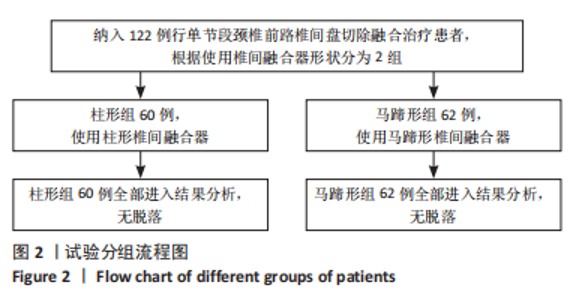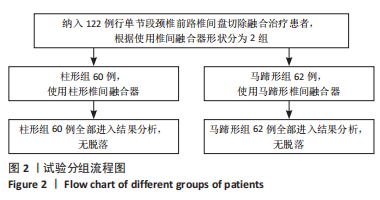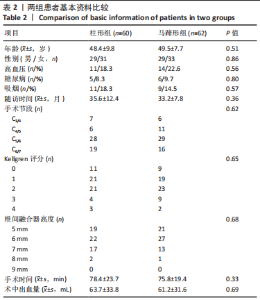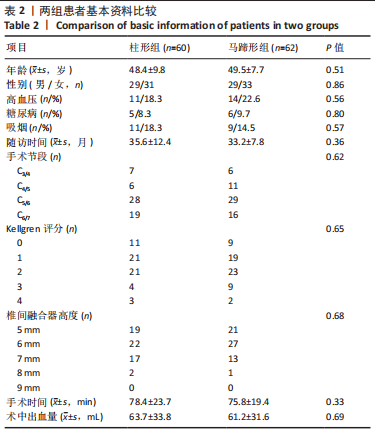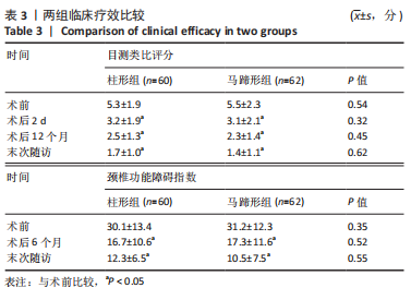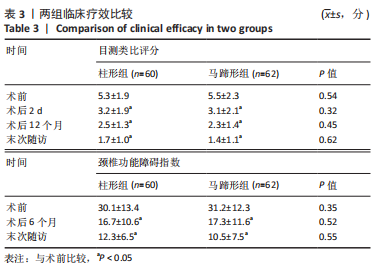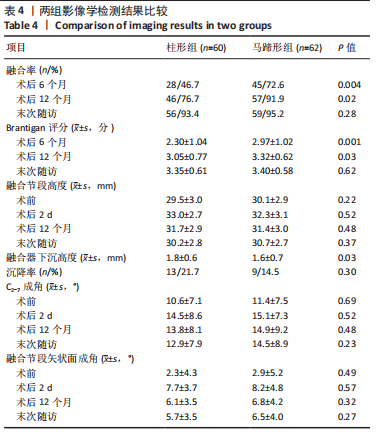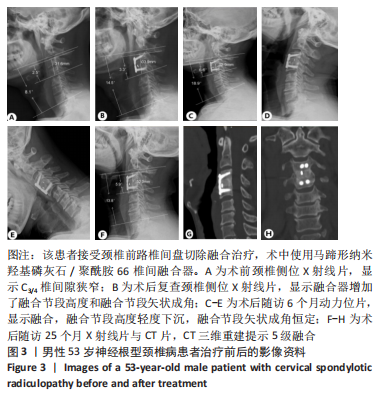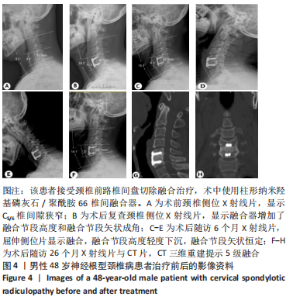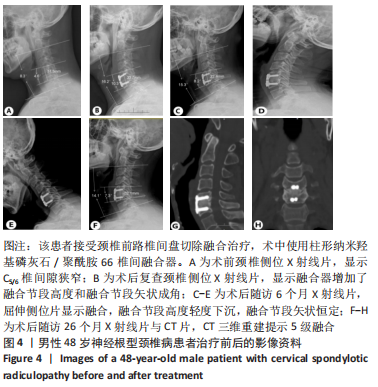Chinese Journal of Tissue Engineering Research ›› 2023, Vol. 27 ›› Issue (30): 4830-4835.doi: 10.12307/2023.832
Previous Articles Next Articles
Effect of nano-hydroxyapatite/polyamide-66 intervertebral fusion cage shape on the efficacy of anterior cervical discectomy and fusion
Xu Shicai, Ma Fei, Tang Chao, Liao Yehui, Tang Qiang, Chen Shiyu, Li Yang, Zhou Jiajun, Wang Qing, Zhong Dejun
- Department of Orthopedics, Affiliated Hospital of Southwest Medical University, Luzhou 646000, Sichuan Province, China
-
Received:2022-09-28Accepted:2022-11-16Online:2023-10-28Published:2023-04-03 -
Contact:Zhong Dejun, MD, Chief physician, Department of Orthopedics, Affiliated Hospital of Southwest Medical University, Luzhou 646000, Sichuan Province, China -
About author:Xu Shicai, Master candidate, Physician, Department of Orthopedics, Affiliated Hospital of Southwest Medical University, Luzhou 646000, Sichuan Province, China Ma Fei, Master, Physician, Department of Orthopedics, Affiliated Hospital of Southwest Medical University, Luzhou 646000, Sichuan Province, China Xu Shicai and Ma Fei contributed equally to this article. -
Supported by:Southwest Medical University Foundation Project, No. 2020ZRQNB041 (to TQ)
CLC Number:
Cite this article
Xu Shicai, Ma Fei, Tang Chao, Liao Yehui, Tang Qiang, Chen Shiyu, Li Yang, Zhou Jiajun, Wang Qing, Zhong Dejun. Effect of nano-hydroxyapatite/polyamide-66 intervertebral fusion cage shape on the efficacy of anterior cervical discectomy and fusion[J]. Chinese Journal of Tissue Engineering Research, 2023, 27(30): 4830-4835.
share this article
Add to citation manager EndNote|Reference Manager|ProCite|BibTeX|RefWorks
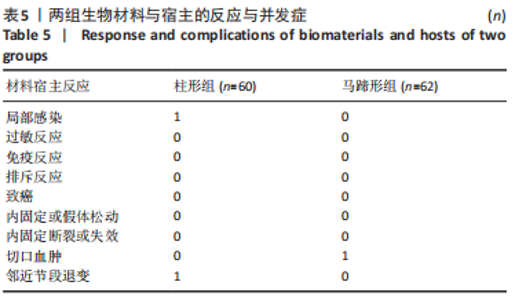
两组手术前后的融合节段高度、C2-7角、融合节段矢状成角比较差异均无显著性意义(P > 0.05)。末次随访时,柱形组融合器下沉高度高于马蹄形组(P=0.03),两组融合器下沉率比较差异无显著性意义(P=0.30)。 柱形组术后6个月融合28例,术后12个月融合46例,末次随访融合56例;马蹄形组术后6个月融合45例,术后12个月融合57例,末次随访融合59例。马蹄形组术后6,12个月的骨融合率高于柱形组(P < 0.01,P=0.02),两组末次随访的融合率比较差异无显著性意义(P=0.28)。 马蹄形组术后6,12个月的Brantigan评分均优于柱形组(P < 0.01,P=0.03),两组末次随访的Brantigan评分比较差异无显著性意义(P=0.62)。 2.6 并发症及植入物与宿主的生物相容性 柱形组中1例患者术后发生伤口感染,为浅表伤口的感染,与深部植入物无关。马蹄形组中1例患者发生术后皮下血肿。柱形组中有1患者在术后30个月后因邻近节段退变而行翻修手术。经相应治疗,所有并发症均治愈。两组植入内固定材料与椎间融合器后均未发生免疫排斥反应,均无钢板及椎间融合器的移位、神经并发症及假关节形成,见表5。"
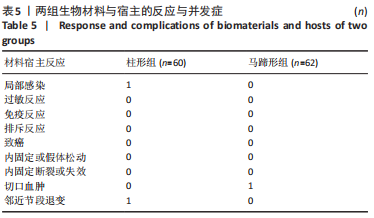
| [1] CLOWARD RB. The anterior approach for removal of ruptured cervical disks. J Neurosurg. 1958;15(6):602-617. [2] JACOBS W, WILLEMS PC, VAN LIMBEEK J, et al. Single or double-level anterior interbody fusion techniques for cervical degenerative disc disease. Cochrane Database Syst Rev. 2011;(1):Cd004958. [3] SMITH GW, ROBINSON RA. The treatment of certain cervical-spine disorders by anterior removal of the intervertebral disc and interbody fusion. J Bone Joint Surg Am. 1958;40-a(3):607-624. [4] YUE WM, BRODNER W, HIGHLAND TR. Long-term results after anterior cervical discectomy and fusion with allograft and plating: a 5- to 11-year radiologic and clinical follow-up study. Spine (Phila Pa 1976). 2005; 30(19):2138-2144. [5] 刘浩,盛厦庆,杨毅,等.颈椎前路钩椎关节融合与传统椎骨终板间融合的融合时效比较:一项前瞻性随机对照研究[J].中国脊柱脊髓杂志,2022,32(5):410-417. [6] HU B, YANG X, HU Y, et al. The n-HA/PA66 Cage Versus the PEEK Cage in Anterior Cervical Fusion with Single-Level Discectomy During 7 Years of Follow-Up. World Neurosurg. 2019;123:e678-e684. [7] LIU JM, XIONG X, PENG AF, et al. A comparison of local bone graft with PEEK cage versus iliac bone graft used in anterior cervical discectomy and fusion. Clin Neurol Neurosurg. 2017;155:30-35. [8] PARK S, LEE DH, HWANG S, et al. Feasibility of local bone dust as a graft material in anterior cervical discectomy and fusion. J Neurosurg Spine. 2019:1-6.bdoi: 10.3171/2019.3.SPINE181416 [9] HU B, WANG L, SONG Y, et al. A comparison of long-term outcomes of nanohydroxyapatite/polyamide-66 cage and titanium mesh cage in anterior cervical corpectomy and fusion: A clinical follow-up study of least 8 years. Clin Neurol Neurosurg. 2019;176:25-29. [10] WANG X, LI Y, WEI J, et al. Development of biomimetic nano-hydroxyapatite/poly(hexamethylene adipamide) composites. Biomaterials. 2002;23(24):4787-4791. [11] YANG X, CHEN Q, LIU L, et al. Comparison of anterior cervical fusion by titanium mesh cage versus nano-hydroxyapatite/polyamide cage following single-level corpectomy. Int Orthop. 2013;37(12):2421-2427. [12] KIM HS, SONG JS, HEO W, et al. Comparative Study between a Curved and a Wedge PEEK Cage for Single-level Anterior Cervical Discectomy and Interbody Fusion. Korean J Spine. 2012;9(3):181-186. [13] KELLGREN JH, LAWRENCE JS. Radiological assessment of osteo-arthrosis. Ann Rheum Dis. 1957;16(4):494-502. [14] MA F, XU S, LIAO Y, et al. Using a mixture of local bone dust and morselized bone as graft materials in single- and double-level ACDF. BMC Musculoskelet Disord. 2021;22(1):510. [15] BRANTIGAN JW, STEFFEE AD. A carbon fiber implant to aid interbody lumbar fusion. Two-year clinical results in the first 26 patients. Spine (Phila Pa 1976). 1993;18(14):2106-2107. [16] 唐强,廖烨晖,唐超,等.椎间融合器的置入方式对腰椎融合效果的影响[J].中国脊柱脊髓杂志,2019,29(12):1071-1079. [17] STEFFEN T, TSANTRIZOS A, AEBI M. Effect of implant design and endplate preparation on the compressive strength of interbody fusion constructs. Spine (Phila Pa 1976). 2000;25(9):1077-1084. [18] LU T, LIU C, YANG B, et al. Single-Level Anterior Cervical Corpectomy and Fusion Using a New 3D-Printed AnatomyAdaptive Titanium Mesh Cage for Treatment of Cervical Spondylotic Myelopathy and Ossification of the Posterior Longitudinal Ligament: A Retrospective Case Series Study. Med Sci Monit. 2017;23:3105-3114. [19] CHEN Y, CHEN D, GUO Y, et al. Subsidence of titanium mesh cage: a study based on 300 cases. J Spinal Disord Tech. 2008;21(7):489-492. [20] DAS K, COULDWELL WT, SAVA G, et al. Use of cylindrical titanium mesh and locking plates in anterior cervical fusion. Technical note. J Neurosurg. 2001;94(1 Suppl):174-178. [21] 陈豪,王利民,谭洪宇,等.比较纳米羟基磷灰石/聚酰胺66人工椎体与自体髂骨在颈椎前路减压融合中的应用[J].中国组织工程研究与临床康复,2011,15(12):2195-2198. [22] YANG X, LIU L, SONG Y, et al. Outcome of single level anterior cervical discectomy and fusion using nano-hydroxyapatite/polyamide-66 cage. Indian J Orthop. 2014;48(2):152-157. [23] QIAN X, YUAN F, ZHIMIN Z, et al. Dynamic perfusion bioreactor system for 3D culture of rat bone marrow mesenchymal stem cells on nanohydroxyapatite/polyamide 66 scaffold in vitro. J Biomed Mater Res B Appl Biomater. 2013;101(6):893-901. [24] ABD EL-FATTAH H, HELMY Y, EL-KHOLY B, et al. In vivo animal histomorphometric study for evaluating biocompatibility and osteointegration of nano-hydroxyapatite as biomaterials in tissue engineering. J Egypt Natl Canc Inst. 2010;22(4):241-250. [25] 欧云生,蒋电明,权正学,等.n-HA/PA66复合生物活性融合器在颈椎病前路减压融合术中的初步应用研究[J].生物医学工程学杂志, 2010,27(2):324-327. [26] HARA T, OHARA Y, ABE E, et al. Cervical endplate bone density distribution measured by CT osteoabsorptiometry and direct comparison with mechanical properties of the endplate. Eur Spine J. 2021;30(9):2557-2564. [27] CHENG CC, ORDWAY NR, ZHANG X, et al. Loss of cervical endplate integrity following minimal surface preparation. Spine (Phila Pa 1976). 2007;32(17):1852-1855. [28] LOU J, LIU H, RONG X, et al. Geometry of inferior endplates of the cervical spine. Clin Neurol Neurosurg. 2016;142:132-136. |
| [1] | Zhou Yanjie, Cao Chunfeng, Zhang Zhongzu, Niu Xiong, Wang Xin, Yang Zaihai, Zhou Liang, Li Bo. Meta-analysis of anterior cervical decompression and fusion ROI-CTM self-locking system in treatment of degenerative cervical spondylosis [J]. Chinese Journal of Tissue Engineering Research, 2025, 29(3): 617-627. |
| [2] | Liang Jiyao, Zhou Honghai, Wei Guikang, Su Shaoting, Chen Longhao, He Xinyu, Liu Liangpu. Quantification of in vivo biomechanics and analysis of influencing factors in cervical spine fixed-point rotation manipulation [J]. Chinese Journal of Tissue Engineering Research, 2025, 29(3): 486-492. |
| [3] | Shen Yurong, Nai Rentong, Zhao Ling, Liu Feigang, Yin Caoyang, Gu Yuanping, Chen Tieyi. Influence of NIC X-FILE and DENCO Pre-Shaper nickel-titanium instruments on the shaping of simulated curved canals [J]. Chinese Journal of Tissue Engineering Research, 2024, 28(3): 387-391. |
| [4] | Yang Yunxiao, Zhao Yu, Wang Minghai, Yang Zezheng, Wang Jinwu. 3D printed personalized cervical orthopedic brace can alleviate and treat early cervical spondylosis [J]. Chinese Journal of Tissue Engineering Research, 2024, 28(29): 4639-4644. |
| [5] | Wang Shiyu, Huang Yangyang, Liu Hao, Yang Li, Fan Dian, Yuan Changyong, Wang Penglai. Effect of arch shapes and missing second premolars on anchorage during maxillary molar distalization with clear aligners [J]. Chinese Journal of Tissue Engineering Research, 2024, 28(28): 4541-4546. |
| [6] | Yang Yunxiao, Huang Chenglan, Hou Yutong, Yao Yuan, Zhao Yu Xu, Yuanjing, Yang Zezheng, Wang Jinwu. Correlation between sagittal curvature parameters and pain threshold for neck-shoulder muscles in degenerative cervical spondylosis [J]. Chinese Journal of Tissue Engineering Research, 2024, 28(24): 3879-3884. |
| [7] | Li Xingyu, Zhou Jie, Li Shasha, Zhang Tianxi, Guo Guoning, Yu Anyong, Deng Jiang, Ye Peng. Repair of infected osteochondral defect with sustained release vancomycin three-dimensional scaffold in rabbits [J]. Chinese Journal of Tissue Engineering Research, 2024, 28(22): 3509-3516. |
| [8] | Liu Yan, Zheng Xuexin. Performance of 3D-printed polylactic acid-nano-hydroxyapatite/chitosan/doxycycline antibacterial scaffold [J]. Chinese Journal of Tissue Engineering Research, 2024, 28(22): 3532-3538. |
| [9] | Zhang Le, Cao Zhenhua, Zhang Yunfeng, Xu Yangyang, Jin Feng, Su Baoke, Wang Lidong, Wang Xing, Tong Ling, Liu Qinghua, Fang Yuan, Sha Lirong, Wang Haiyan, Li Xiaohe, Li Zhijun. Biomechanical features of posterior “Y” osteotomy and fixation in treatment of ankylosing spondylitis based on finite element simulation analysis [J]. Chinese Journal of Tissue Engineering Research, 2024, 28(12): 1842-1848. |
| [10] | Wang Yanjin, Zhou Yingjie, Chai Xubin, Zhuo Hanjie. Meta-analysis of the efficacy and safety of 3D printed porous titanium alloy fusion cage in anterior cervical discectomy and fusion [J]. Chinese Journal of Tissue Engineering Research, 2023, 27(9): 1434-1440. |
| [11] | Chen Lei, Jia Yanfei, Lyu Huicheng, Zhang Lifeng. Application of T-shaped plate for fractures involving the quadrilateral region of acetabulum [J]. Chinese Journal of Tissue Engineering Research, 2023, 27(4): 578-582. |
| [12] | Ma Hui, Jia Xiangyuan, Yang Haotian, Yuan Lin, Li Yafeng, Zhao Xueqian, Jia Yusong. Total disc replacement for cervical spondylosis with sympathetic symptoms [J]. Chinese Journal of Tissue Engineering Research, 2023, 27(36): 5818-5822. |
| [13] | Zhao Kang, Lin Si, Ge Xiaotian, Du Xinrui, Han Yingchao. Biosafety evaluation of poly(lactic acid)/nano-hydroxyapatite composite microspheres [J]. Chinese Journal of Tissue Engineering Research, 2023, 27(34): 5497-5504. |
| [14] | Zhang Liang, Han Zekui, Zang Yixin, Han Zhenjia, Wang Xinyu. Design and three-dimensional finite element analysis of 3D printed individualized titanium mesh with a bionic porous spider web-shaped structure [J]. Chinese Journal of Tissue Engineering Research, 2023, 27(30): 4796-4801. |
| [15] | Ran Yu, Bai Chunxiao, Liu Chuyin, Zhao Xueqian, Long Shuiwen, Qin Changlong, Li Zhongze, Zhang Chao, Jia Yusong, Chen Jiang. Changes in sagittal parameters of cervical spine after single-level Mobi-C artificial disc replacement and ROI-C anterior cervical fusion [J]. Chinese Journal of Tissue Engineering Research, 2023, 27(27): 4297-4303. |
| Viewed | ||||||
|
Full text |
|
|||||
|
Abstract |
|
|||||
